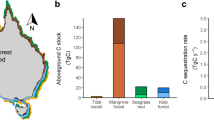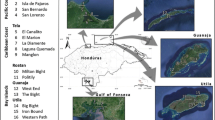Abstract
Threatened globally, mangrove forests provide many ecosystem services, including blue carbon storage. These forests, and the services that they provide, are distributed across spatio-temporally variable coastal landscapes and a range of environmental conditions, though this variability is underappreciated in the blue carbon literature. The Galapagos, Ecuador, presents the opportunity to explore spatial variability in carbon storage. This volcanically active archipelago features rocky shores and arid conditions at low elevations (< 500 mm/year), with patchy forests under far from optimal conditions. At 29 mangrove sites, we cored from the sediment surface down to basement rock, and samples were dried, weighed, and analyzed for their carbon content by GC–MS. Belowground carbon stocks range from < 50 Mg/ha to > 500 Mg/ha, i.e. from practically no carbon to values typical of lush, productive mangroves. This variability is driven principally by variation in sediment depth, with high inter-site variance associated with underlying lava substrate. The first to measure mangrove blue carbon in the Galapagos, this study reveals the spatial heterogeneity of the islands’ patchy mangroves. These results underscore the importance of local ecosystem constraints and natural variability in ecosystem service valuation for conservation prioritization.




Similar content being viewed by others
Change history
26 August 2019
In the original publication, the affiliation of second author and acknowledgements were incorrectly published. The correct affiliation and acknowledgements are given below.
References
Aburto-Oropeza O, Ezcurra E, Danemann G, Valdez V, Murray J, Sala E (2008) Mangroves in the Gulf of California increase fishery yields. PNAS 105:10456–10459
Adame MF, Kauffman JB, Medina I, Gamboa JN, Torres O, Caamal JP et al (2013) Carbon stocks of tropical coastal wetlands within the karstic landscape of the Mexican Caribbean. PLoS ONE 8:e56569. https://doi.org/10.1371/journal.pone.0056569
Bouillon S, Borges AV, Castañeda-Moya A, Diele K, Dittmar T, Duke NC et al (2008) Mangrove production and carbon sinks: a revision of global budget estimates. Glob Biogeochem Cycles 22:GB2013. https://doi.org/10.1016/j.molimm.2014.11.005
Chapman VJ (1976) Mangrove vegetation. Strauss & Cramer, Leutershausen
Chmura GL, Anisfield SC, Cahoon DR, Lynch JC (2003) Global carbon sequestration in tidal, saline wetland soils. Glob Biogeochem Cycles 17(4):1111. https://doi.org/10.1029/2002GB001917
Cintrón G, Lugo AE, Pool DJ, Morris G (1978) Mangroves of arid environments in Puerto Rico and adjacent islands. Biotropica 10(2):110–121
Costanza R, de Groot R, Sutton P, van der Ploeg S, Anderson SJ, Kubiszewski I et al (2014) Changes in the global value of ecosystem services. Glob Environ Change 26:152–158
d’Ozouville N, Auken E, Sorensen K, Violette S, de Marsily G, Deffontaines B, Merlen G (2008) Extensive perched aquifer and structural implications revealed by 3D resistivity mapping in a Galapagos volcano. Earth Planet Sci Lett 269:518–522
Donato DC, Kauffman JB, Murdiyarso D, Kurnianto S, Stidham M, Manninen M (2011) Mangroves among the most carbon-rich forests in the tropics. Nat Geosci 4:293–297
Duke NC (1992) Mangrove floristics and biogeography. In: Robertson AI, Alongi DM (eds) Coastal and estuarine studies. American Geophysical Union, Washington, DC, pp 63–100
Dvorak M, Vargas H, Fessl B, Tebbich S (2004) On the verge of extinction: a survey of the mangrove finch Cactospiza heliobates and its habitat on the Galápagos Islands. Oryx 38(2):171–179
Ewel KC, Twilley RR, Ong JE (1998) Different kinds of mangrove forests provide different goods and services. Glob Ecol Biogeogr Lett 7:83–94
Ezcurra P, Ezcurra E, Garcillán PP, Costa MT, Aburto-Oropeza O (2016) Coastal landforms and accumulation of mangrove peat increase carbon sequestration and storage. PNAS 113(16):4404–4409
Hamilton SE, Lovette J (2015) Ecuador’s mangrove forest carbon stocks: a spatiotemporal analysis of living carbon holdings and their depletion since the advent of commercial aquiculture. PLoS ONE 10(3):e0118880. https://doi.org/10.1371/journal.pone.0118880
Hogarth PJ (1999) The biology of mangroves. Oxford University Press Inc, New York
Howmiller R, Weiner A (1968) A limnological study of a mangrove lagoon in the Galapagos. Ecology 49(6):1184–1186
INGALA, PRONAREG, ORSTOM (1989) Inventario cartográfico de los recursos naturales, geomorfología, vegetación, hídricos, ecológicos y biofísicos de las Islas Galápagos, Ecuador. 1:100,000 maps. INGALA, Quito
Jardine SL, Siikamäki JV (2014) A global predictive model of carbon in mangrove soils. Environ Res Lett 9:104013. https://doi.org/10.1088/1748-9326/9/10/104013
McKee KL, Cahoon DR, Feller IC (2007) Caribbean mangroves adjust to rising sea level through biotic controls on change in soil elevation. Glob Ecol Biogeogr 16:545–556
Moity N, Delgado B, Salinas-de-León P (2019) Mangroves in the Galapagos islands: distribution and dynamics. PLOS ONE 14(1):e0209313. https://doi.org/10.1371/journal.pone.0209313
Nelleman C, Corcoran E, Duarte CM, Valdés L, De Young C, Fonseca L, Grimsditch G (eds) (2009) Blue carbon: a rapid response assessment. United Nations Environment Programme, GRID-Arendal, Arendal
Odum WE, Heald EJ (1975) The detritus-based food web of an estuarine mangrove community. In: Cronin LE (ed) Estuarine research, vol I. chemistry, biology, and the estuarine system. Academic Press Inc., New York, pp 265–286
Pool DJ, Snedaker SC, Lugo AE (1977) Structure of mangrove forests in Florida, Puerto Rico, Mexico, and Costa Rica. Biotropica 9:195–212
Ramnarine R, Voroney RP, Wagner-Riddle C, Dunfield KE (2011) Carbonate removal by acid fumigation for measuring the δ13C of soil organic carbon. Can J Soil Sci 91:247–250
Rivera-Monroy VH, Lee SY, Kristensen E, Twilley RR (eds) (2017) Mangrove ecosystems: a global biogeographic perspective. Springer, Cham
Rowland SK (1996) Slopes, lava flow volumes, and vent distributions on Volcán Fernandina, Galápagos Islands. J Geophys Res 101(B12):27657–27672
Song C, White BL, Heumann BW (2011) Hyperspectral remote sensing of salinity stress on red (Rhizophora mangle) and white (Laguncularia racemosa) mangroves on Galapagos Islands. Remote Sens Lett 2(3):221–230
Stoddart DR (1980) Mangroves as successional stages, inner reefs of the northern Great Barrier Reef. J Biogeogr 7:269–284
Tanner MK, Moity N, Costa MT, Jarrin JM, Aburto-Oropeza O, Salinas-de-León P (in press) Mangroves in the Galapagos: ecosystem services and their valuation. Ecol Econ
Thom BG (1967) Mangrove ecology and deltaic geomorphology: tabasco, Mexico. J Ecol 55(2):301–343
Thomas S (2014) Blue carbon: knowledge gaps, critical issues, and novel approaches. Ecol Econ 107:22–38
Trueman M, d’Ozouville N (2010) Characterizing the Galapagos terrestrial climate in the face of global climate change. Galapagos Res 67:26–37
Valiela I, Bowen JL, York JK (2001) Mangrove forests: one of the world’s threatened major tropical environments. BioScience 51(10):807–815
Wiggins IL, Porter DM (1971) Flora of the Galápagos Islands. Stanford University Press, Stanford
Acknowledgements
Financial support was provided by the Helmsley Charitable Trust and the International Community Foundation, and graduate fellowship support for M.T.C. by the National Science Foundation. We thank SIO and CDF staff, especially E. Rastoin, for facilitating travel and field logistics; J. J. Cota-Nieto and I. Mascarenas for fieldwork; K. Laface and E. Navarro for lab assistance; and E. Cleland and J. Leichter for providing useful comments on the manuscript. Sediment samples were collected and exported from Ecuador using the Ministerio del Ambiente permit 054-2015 DPNG. The data in this paper are available in the Supplementary Material.
Funding
Financial support was provided by the Helmsley Charitable Trust and the International Community Foundation, and graduate fellowship support for M.T.C. by the National Science Foundation.
Author information
Authors and Affiliations
Corresponding author
Ethics declarations
Conflict of interest
The authors declare that they have no conflict of interest.
Electronic supplementary material
Below is the link to the electronic supplementary material.
Rights and permissions
About this article
Cite this article
Costa, M.T., Salinas-de-León, P. & Aburto-Oropeza, O. Storage of blue carbon in isolated mangrove forests of the Galapagos’ rocky coast. Wetlands Ecol Manage 27, 455–463 (2019). https://doi.org/10.1007/s11273-019-09653-8
Received:
Accepted:
Published:
Issue Date:
DOI: https://doi.org/10.1007/s11273-019-09653-8




